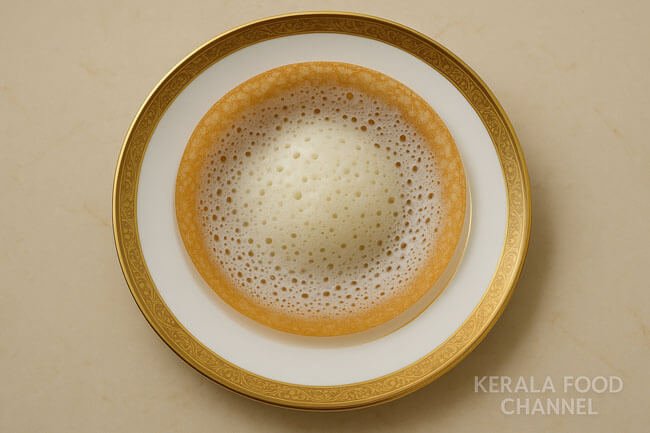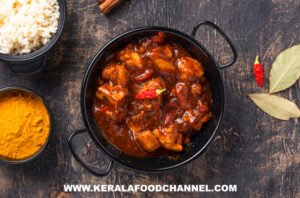Homemade Appams (No Yeast!) – Soft and Fluffy Palappam
What Makes Appams So Irresistibly Special?
If you’ve ever enjoyed a South Indian breakfast, chances are you’ve tasted the magic of Appams—those beautifully laced rice pancakes with fluffy centers and crispy edges. Also called Palappam, they are a Kerala favorite usually made from fermented rice batter and coconut milk.
But what if you could enjoy the same deliciousness without the wait or the yeast? Yes, that’s exactly what this instant no-yeast Appam recipe offers. It’s fuss-free, beginner-friendly, and brings the comforting flavors of Kerala right to your kitchen in under 30 minutes.
🌿 Why Choose a No-Yeast Appam Recipe?
Let’s be honest—we don’t always have the luxury of waiting 8–12 hours for a batter to ferment. Whether you’re in a rush, don’t have yeast at home, or are simply avoiding it due to dietary restrictions, this recipe has you covered.
Here’s why this version is a winner:
-
✅ Quick prep—No long fermentation or yeast activation
-
✅ Easily digestible with natural curd-based leavening
-
✅ Perfect texture—crispy outer ring, pillowy center
-
✅ Great for busy mornings or surprise dinner guests
🍚 Ingredients for Instant Homemade Appams (No Yeast Needed)
To make about 12–14 delicious appams, gather the following:
📦 Dry Ingredients
-
Raw rice (Idli rice or Sona Masoori) – 2 cups
-
Cooked rice – ½ cup (preferably parboiled or leftover plain rice)
-
Freshly grated coconut – ½ cup
-
Sugar – 1 tbsp (adds mild sweetness)
-
Salt – ¾ tsp
-
Baking soda – ¼ tsp
🥛 Wet Ingredients
-
Water – 1 to 1½ cups (for grinding)
-
Thick curd (plain yogurt) – 2 tbsp
-
Coconut milk (optional) – ¼ cup for added richness
💡 Pro Tip: Use fresh coconut if you can—it truly elevates the flavor. Frozen coconut works fine too—just thaw it first.
👩🍳 How to Make Appams Without Yeast – Step-by-Step Guide
This recipe is not just easy—it’s also quite meditative! Let’s walk through it.
Step 1: Soak the Rice
-
Rinse the raw rice 2–3 times until the water runs clear.
-
Soak in clean water for 4–6 hours (or overnight for convenience).
⏱️ In a hurry? Use warm water to soak and cut the time to about 2.5 hours.
Step 2: Grind the Batter
-
Drain the soaked rice.
-
In a blender or wet grinder, add:
-
Soaked rice
-
Cooked rice
-
Grated coconut
-
Curd
-
Sugar
-
-
Add water little by little and grind until smooth.
The consistency should be like thin dosa batter—pourable, but not too watery.
Step 3: Rest the Batter
-
Pour the batter into a large bowl.
-
Mix in the salt and let it rest for about 1 to 2 hours at room temperature.
🧪 Here’s the trick: Add the baking soda only right before cooking. This mimics the aeration of yeast and gives the appam its signature fluff.
Step 4: Cook the Appams
-
Heat a non-stick Appam chatti or any deep skillet with a lid.
-
Lightly grease the pan with coconut oil.
-
Pour a ladle of batter into the center.
-
Immediately swirl the pan to spread the batter into a circle. The edges should be thin, and the center thick.
-
Cover with a lid and cook for 2–3 minutes on low-medium heat.
✅ No flipping needed. Appams are cooked on just one side.
Step 5: Serve Hot and Fresh!
-
Gently lift the appam with a spatula.
-
Serve immediately with your favorite curry or stew.
🍛 What to Serve with Appams – Delicious Pairings
Appams are like a blank canvas—so versatile that they shine with both savory and sweet sides.
🥘 Savory Pairings:
-
Kerala Vegetable Stew – Coconut milk-based curry with veggies
-
Egg Roast – Hard-boiled eggs in spicy onion-tomato gravy
-
Chicken Ishtu (Stew) – Mild, creamy chicken in coconut milk
-
Kadala Curry – Kerala-style black chickpea curry
🍯 Sweet Pairings:
-
Thick coconut milk + sugar drizzle
-
Jaggery syrup
-
Banana slices & honey for a kid-friendly version
🍽️ Tip: Appams are best eaten fresh and hot, straight from the pan. They tend to lose their softness if left out for too long.
🥗 Nutritional Benefits of No-Yeast Appams
Here’s a quick breakdown of the health perks per serving:
| Nutrient | Approx. Value per Appam |
|---|---|
| Calories | ~120 kcal |
| Carbohydrates | 20g |
| Protein | 2.5g |
| Fat | 3g |
| Fiber | 0.5g |
| Gluten-Free | ✅ Yes |
| Vegan Option | ✅ With vegan curd |
🟢 Health Highlights:
-
Gluten-free & gut-friendly
-
Low oil, thanks to steam-cooking
-
Rich in complex carbs from rice and coconut
-
Uses natural fermentation from curd
Who Should Avoid Appams?
While appams are generally safe and healthy, keep the following in mind:
-
Not ideal for diabetics in large quantities (white rice = high glycemic index)
-
Not suitable for keto/low-carb diets
-
Avoid if you have a coconut allergy
❓ Frequently Asked Questions (FAQs)
1. Can I skip baking soda?
Technically yes—but the appams might turn out flat. Just ¼ tsp ensures the right fluff and rise.
2. How can I make these appams vegan?
Substitute curd with plant-based yogurt (like coconut or almond yogurt) and skip ghee if you plan to use it.
3. Can I refrigerate the batter?
Absolutely. Store in an airtight container for up to 3 days. Stir well before use and add baking soda only before cooking.
4. How are Appams different from Dosas or Idlis?
Appams are soft and spongy in the center with crispy laced edges, while dosas are thin and crispy throughout. Idlis are steamed and fluffier, but without the crispy texture.
5. Can I use rice flour instead of soaked rice?
Yes! As a quick fix, mix:
-
1 cup rice flour
-
½ cup coconut milk
-
1 tbsp cooked rice
-
Water + baking soda
The taste may differ slightly, but it works in a pinch.
💡 Pro Tips for Perfect Appams Every Time
-
Use a curved appam pan with a lid for even steaming.
-
Swirl immediately after pouring the batter—this creates the signature lacey edge.
-
Thin batter = lacy edges, thick batter = dense appam.
-
Never stack appams while hot—they may become soggy.
Final Thoughts: Why You’ll Love This No-Yeast Appam Recipe
Whether you’re cooking for family, guests, or just yourself, these no-yeast appams will never fail to impress. They’re quick, wholesome, and incredibly flavorful. You don’t need fancy ingredients or long fermentation—just a blender, a pan, and 30 minutes.
So next time you crave something warm, fluffy, and soul-satisfying, whip up a batch of these appams and bring the taste of Kerala into your kitchen—minus the wait!






